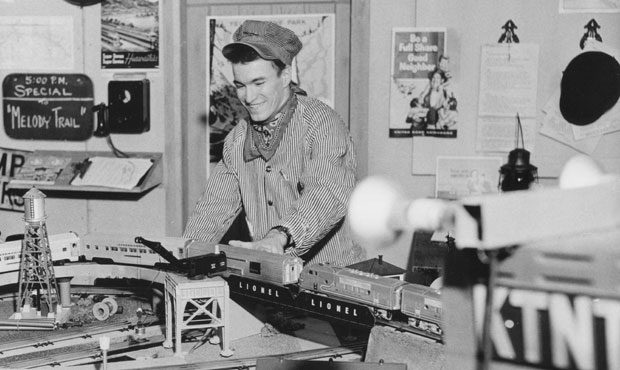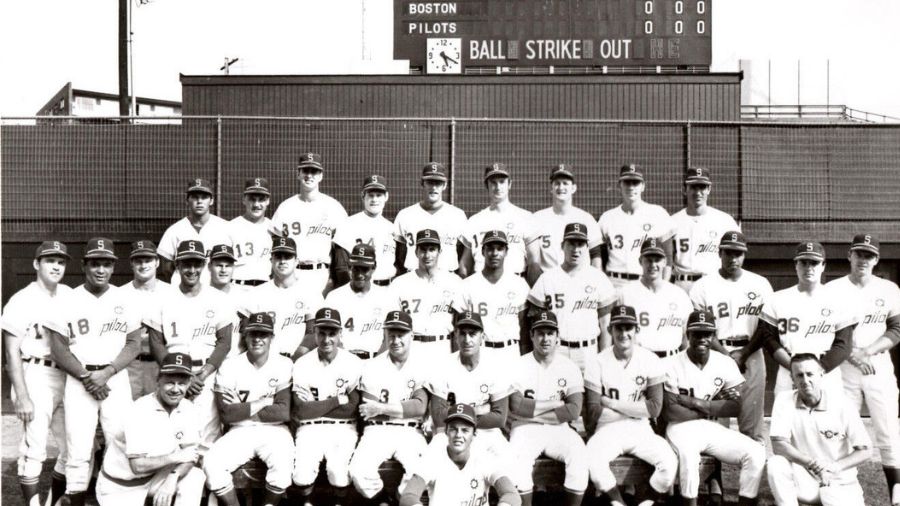‘Victorian Internet’ hits Seattle October 1864
Oct 11, 2023, 7:34 AM | Updated: 7:37 am

Seattle was first connected to the outside world via telegraph in October 1864, when the city looked very much like this photo taken on Commercial Street (now First Avenue) near the telegraph office in 1865. (Courtesy MOHAI)
(Courtesy MOHAI)
Editor’s Note: Originally published October 18, 2017
A cannon was fired in downtown Seattle at 1 p.m. on the afternoon of Oct. 26, 1864. The occasion was the arrival of the first message to reach the city via telegraph.
RELATED: Brigade terrorized the Northwest in the 1970s
It came to the Yesler Building, a small wooden structure at the southwest corner of Commercial Street and Mill Street, nowadays better known as First and Yesler.
“A courier from the front reports Price in full retreat, closely pursued by our forces,” it reportedly read. “Sherman was pushing Hood and rather trying to coop him up in the valley and starve him to death.”
It was Civil War news that arrived that day, and it was already about 24 hours old. But it was a game-changer. No longer would messages be restricted to travel at the speed of horse, boat, or even train. Local newspapers could now publish news from afar that was just days old, rather than weeks or even months after the fact. A place like far-off Seattle in Washington Territory could begin to feel like it was connected to the United States.
Daniel Walker Howe is professor emeritus at UCLA and author of “What Hath God Wrought, The Transformation of America, 1815-1848” from Oxford University Press. He says that beginning in the 1840s and thanks to a number of inventors such as Samuel Morse, the telegraph destroyed time and distance, and made the world smaller, and life better.
Effects of the telegraph
“Enthusiasm for the telegraph was quite universal,” Howe said. “The telegraph appealed to a whole lot of different elements in American culture and society of that time. People love it because it demonstrates scientific progress. And in the 19th century, they’re aware of a lot of scientific progress being made, and they’re quite enthusiastic about it, and they believe in progress in general with justification.”
In the mid 19th century, Howe said, “life is improving for a lot of people, especially if you were free and white and living in the United States.”
But most importantly, according to Howe, the telegraph mobilized capital, which was absolutely critical to the growth of a place like tiny, remote Seattle in the 1860s.
“It became ever so much more practical to raise money to invest in factories or any kind of economic activity,” Howe said. “It makes a huge difference if you know what stocks are selling for and what the prices of commodities are in New York, even though you’re out in Washington Territory.”
Before the telegraph allowed for near-instantaneous communication to financial centers in San Francisco and points east, Howe said “if you look and see who had invested in business enterprise, you will see that the investors usually lived pretty nearby and they wanted to invest in an enterprise that they can really trust, which means maybe it has to be run by their brother-in-law or their cousin.”
Howe says connection via the telegraph meant “you can have genuinely publicly-held companies” and that investors could “compare the performance of one company with another.”
It’s easy to forget that Seattle’s destiny as the economic capital of the Northwest wasn’t a sure thing circa 1870. According to census figures, Seattle had a population of just 1,100, while Olympia had 1,200 and Walla Walla had 1,400. Meanwhile, Portland, Oregon had a whopping 8,300 residents. The only true metropolis on the West Coast at this time was San Francisco, which had a population of more than 150,000.
And it was San Francisco where the transcontinental telegraph had first arrived in October 1861, as part of a federally-subsidized project of the private company called Western Union.
Telegraph makes its way north
In 1863, a group of local investors in Portland saw the value in connecting with San Francisco (an earlier effort, around 1855 or 1856, had tried and failed). The new concern built lines as far south as Eugene, but then ran out of money and sold out to the California State Telegraph Company, a smaller West Coast rival of the larger Western Union. With this new infusion of resources, crews worked from the north and south and met up at Roseburg, Oregon in early 1864, with telegraph service beginning in Portland sometime around March 1, 1864.
Next, the company set its sights north, aiming for New Westminster, which was then the capital of British Columbia (the capital would move a few years later to Vancouver Island). Seattle, rather than Olympia, was picked to be one of the main stations along the line.
Professor Howe says that in the 1860s, the federal government recognized the value in connecting all of the United States and even the remote corners like Washington Territory, especially during the early years of the Civil War.
“The government wanted the people in the far northwest to feel an immediate sense of being an American and being involved in the wartime struggle,” Howe said. “It’s very clear that the government wanted the telegraph to be reinforcing these feelings.”
According to Howe, this policy came straight from the top, from President Lincoln himself.
Lincoln, Howe says, was a devoted consumer of, and advocate for, the telegraph.
“He was the one who kept insisting that he must be in telegraphic contact with his armies and his generals, and learning what they wanted to do and telling them whether to do it or not,” Howe said. “And [Lincoln] is the single most clear explanation for why the Union Army made so much more use of the telegraph than the Confederate Army did. It took the Confederate government in Richmond much longer to learn about what was going on the battlefront, because they were still using conventional communications like guys on horseback, galloping along.”
RELATED: KIRO Radio accidentally saves American history
Howe says that the wartime information in the first message to reach Seattle back in October 1864 likely originated directly from battlefronts; in this specific case, from Missouri and Tennessee. One local history book says the message came through Portland, via Kansas City and New York. At each of those cities along the way, a telegraph operator would’ve had to receive the message, and then re-send in Morse code via telegraph key.
“Of course, it would have had to be transmitted from the battlefront to Washington and thence to New York even before those transmissions occurred,” Howe said, which explains why it took a full day to get here.
The 1860s were a time of consolidation, and the California State Telegraph Company sold out to Western Union in 1865, as Western Union came to monopolize the telegraph industry in the United States.
Tom Standage, author of a seminal 1998 book about the telegraph and its similarities to the web called “The Victorian Internet,” says this was a perfectly natural state of affairs, then and now.
Introducing Western Union
“You’ve got a big, fast-growing country, and you’ve got the need for one part of the country to communicate with another, [and] you’ve got a system where lots and lots of private companies spring up to meet that need, and you’ve got all of these different networks,” Standage said. “And that all becomes a bit of a mess, and they gradually all get balled up into this enormous monopoly Western Union by the end of the 19th century.”
“Western Union argues that actually it’s great to have a monopoly, because people aren’t wasting time competing with other companies, they just get on with serving customers,” Standage said.
Ironically, Standage says, “This is the same sort of argument we heard from Internet giants more recently.”
It’s hard to quantify how much the telegraph contributed to Seattle’s economic growth in the 1860s and beyond, but it’s easy to see the impact of the rapid delivery of news from afar.
Less than six months after the city was connected, it took just hours for word to reach Seattle on the afternoon of Saturday April 15, 1865 that the man largely responsible for the spread of the telegraph across the United States, had died at the hands of an assassin.
Thanks to the telegraph, Seattleites, like Americans everywhere, could mourn the death of President Lincoln in near real-time.
You can hear Feliks every Wednesday and Friday morning on Seattle’s Morning News with Dave Ross and Colleen O’Brien, read more from him here, and subscribe to The Resident Historian Podcast here. If you have a story idea, please email Feliks here.













